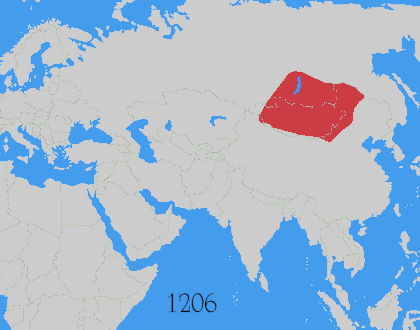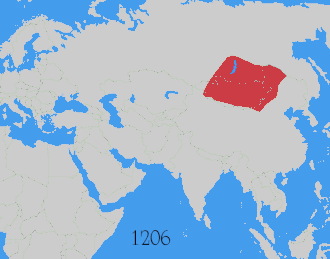Top Qs
Timeline
Chat
Perspective
Mongol invasions and conquests
Series of military campaigns by the Mongol Empire From Wikipedia, the free encyclopedia
Remove ads
The Mongol invasions and conquests took place during the 13th and 14th centuries, creating history's largest contiguous empire, the Mongol Empire (1206–1368), which by 1260 covered large parts of Eurasia. Historians regard the Mongol devastation as one of the deadliest episodes in history.[1][2]
At its height, the Mongol Empire included modern-day Mongolia, China, North Korea, South Korea, Myanmar, Iran, Iraq, Afghanistan, Pakistan, Kashmir, Kazakhstan, Tajikistan, Kyrgyzstan, Turkmenistan, Uzbekistan, Siberia, Georgia, Armenia, Azerbaijan, Turkey, Belarus, Ukraine, Moldova, Romania, and most of European Russia.[3]
Remove ads
Overview
The Mongol Empire developed in the course of the 13th century through a series of victorious campaigns throughout Eurasia. At its height, it stretched from the Pacific to Central Europe. It was later known as the largest contiguous land empire of all time. In contrast with later "empires of the sea" such as the European colonial powers, the Mongol Empire was a land power, fueled by the grass-foraging Mongol cavalry and cattle.[a] Thus most Mongol conquest and plundering took place during the warmer seasons, when there was sufficient grazing for their herds.[4] The rise of the Mongols was preceded by 15 years of wet and warm weather conditions from 1211 to 1225 that allowed favourable conditions for the breeding of horses, which greatly assisted their expansion.[5]
As the Mongol Empire began to fragment from 1260, conflict between the Mongols and Eastern European polities continued for centuries. Mongols continued to rule China into the 14th century under the Yuan dynasty, while Mongol rule in Persia persisted into the 15th century under the Timurid Empire. In the Indian subcontinent, the later Mughal Empire survived into the 19th century.
Remove ads
History and outcomes
Summarize
Perspective
Central Asia

Genghis Khan forged the initial Mongol Empire in Central Asia, starting with the unification of the nomadic tribes of the Merkits, Tatars, Keraites, Turks, Naimans and Mongols. The Buddhist Uighurs of Qocho surrendered and joined the empire. He then continued expansion via conquest of the Qara Khitai[6] and of the Khwarazmian Empire.
Large areas of Islamic Central Asia and northeastern Persia were seriously depopulated,[7] as every city or town that resisted the Mongols was destroyed. Each soldier was given a quota of enemies to execute according to circumstances. For example, after the conquest of Urgench, each Mongol warrior – in an army of perhaps two tumens (20,000 troops) – was required to execute 24 people, or nearly half a million people per said army.[8]
Against the Alans and the Cumans (Kipchaks), the Mongols used divide-and-conquer tactics by first warning the Cumans to end their support of the Alans, whom they then defeated,[9] before rounding on the Cumans.[10] The Alans were recruited into the Mongol forces and known as the Asud, with one unit called "Right Alan Guard" that was combined with "recently surrendered" soldiers. Mongols and Chinese soldiers stationed in the area of the former state of Qocho and in Besh Balikh established a Chinese military colony led by Chinese general Qi Kongzhi.[11]
During the Mongol attack on the Middle East ruled by the Mamluk Sultanate, most of the Mamluk military was composed of Kipchaks and the Golden Horde's supply of Kipchak fighters replenished the Mamluk armies and helped them fight off the Mongols.[9]
Hungary became a refuge for fleeing Cumans.[12]
The decentralized, stateless Kipchaks only converted to Islam after the Mongol conquest, unlike the centralized Karakhanid entity comprising the Yaghma, Qarluqs, and Oghuz who converted earlier to world religions.[13]
The Mongol conquest of the Kipchaks led to a merged society with a Mongol ruling class over a Kipchak-speaking populace which came to be known as Tatar, and which eventually absorbed Armenians, Italians, Greeks, and Crimean Goths in Crimea, the origin of the current Crimean Tatars.[14]
West Asia

The Mongols conquered, by battle or voluntary surrender, the areas of present-day Iran, Iraq, the Caucasus, and parts of Syria and Turkey, with further Mongol raids reaching southwards into Palestine as far as Gaza in 1260 and 1300. The major battles were the siege of Baghdad, when the Mongols sacked the city which had been the center of Islamic power for 500 years and the Battle of Ain Jalut in 1260 in southeastern Galilee, when the Muslim Bahri Mamluks were able to defeat the Mongols and decisively halt their advance for the first time. One thousand North Chinese engineer squads accompanied the Mongol Hulagu Khan during his conquest of the Middle East.[b]
East Asia

Genghis Khan and his descendants launched progressive invasions of China, subjugating the Western Xia in 1209 before destroying them in 1227, defeating the Jin dynasty in 1234 and defeating the Song dynasty in 1279. They made the Kingdom of Dali into a vassal state in 1253 after the Dali King Duan Xingzhi defected to the Mongols and helped them conquer the rest of Yunnan, forced Korea to capitulate through nine invasions, but failed in their attempts to invade Japan, their fleets scattered by kamikaze storms.

The Mongols' greatest triumph was when Kublai Khan established the Yuan dynasty in China in 1271. The dynasty created a "Han Army" (漢軍) out of defected Jin troops and an army of defected Song troops called the "Newly Submitted Army" (新附軍).[16]
The Mongol force which invaded southern China was far greater than the force they sent to invade the Middle East in 1256.[17]
The Yuan dynasty established the top-level government agency Bureau of Buddhist and Tibetan Affairs to govern Tibet, which was conquered by the Mongols and put under Yuan rule. The Mongols also invaded Sakhalin Island between 1264 and 1308. Likewise, Korea (Goryeo) became a semi-autonomous vassal state of the Yuan dynasty for about 80 years.
North Asia
By 1206, Genghis Khan had conquered all Mongol and Turkic tribes in Mongolia and southern Siberia. In 1207 his eldest son Jochi subjugated the Siberian forest people, the Uriankhai, the Oirats, Barga, Khakas, Buryats, Tuvans, Khori-Tumed, and Yenisei Kyrgyz according to chapter 5 of the Secret History of the Mongols. He then organized the Siberians into three tumens. He gave the Telengits and Tolos along the Irtysh to an old companion, Qorchi. While the Barga, Tumed, Buriats, Khori, Keshmiti, and Bashkirs were organized in separate thousands, the Telengit, Tolos, Oirats and Yenisei Kirghiz were numbered into the regular tumens[18] Genghis created a settlement of Chinese craftsmen and farmers at Kem-kemchik after the first phase of the Mongol conquest of the Jin dynasty. The Khagans favored gyrfalcons, furs, women, and Kyrgyz horses for tribute.
Western Siberia came under the Golden Horde.[19] The descendants of Orda Khan, the eldest son of Jochi, directly ruled the area. In the swamps of western Siberia, dog sled Yam stations were set up to facilitate collection of tribute.
In 1270, Kublai Khan sent a Chinese official, with a new batch of settlers, to serve as judge of the Kyrgyz and Tuvan basin areas (益蘭州 and 謙州).[20] Ogedei's grandson Kaidu occupied portions of Central Siberia from 1275 on. The Yuan dynasty army under Kublai's Kipchak general Tutugh reoccupied the Kyrgyz lands in 1293. From then on, the Yuan dynasty controlled large portions of Central and Eastern Siberia.[21]
Eastern and Central Europe


The Mongols invaded and destroyed Volga Bulgaria and Kievan Rus', before invading Poland, Hungary, Bulgaria, and other territories. Over the course of three years (1237–1240), the Mongols razed all the major cities of Russia with the exceptions of Novgorod and Pskov.[22]
Giovanni da Pian del Carpine, the Pope's envoy to the Mongol Great Khan, traveled through Kiev in February 1246 and wrote:
They [the Mongols] attacked Russia, where they made great havoc, destroying cities and fortresses and slaughtering men; and they laid siege to Kiev, the capital of Russia; after they had besieged the city for a long time, they took it and put the inhabitants to death. When we were journeying through that land we came across countless skulls and bones of dead men lying about on the ground. Kiev had been a very large and thickly populated town, but now it has been reduced almost to nothing, for there are at the present time scarce two hundred houses there and the inhabitants are kept in complete slavery.[23]
The Mongol invasions displaced populations on a scale never seen before in central Asia or eastern Europe. Word of the Mongol hordes' approach spread terror and panic.[24] The violent character of the invasions acted as a catalyst for further violence between Europe's elites and sparked additional conflicts. The increase in violence in the affected eastern European regions correlates with a decrease in the elite's numerical skills, and has been postulated as a root of the Great Divergence.[25]
South Asia
From 1221 to 1327, the Mongol Empire launched several invasions into the Indian subcontinent. The Mongols occupied parts of northwestern South Asia for decades. However, they failed to penetrate past the outskirts of Delhi and were repelled from the interior of India. Centuries later, the Mughals, whose founder Babur had Mongol roots, established their own empire in India.
Southeast Asia
Kublai Khan's Yuan dynasty invaded Burma between 1277 and 1287, resulting in the capitulation and disintegration of the Pagan Kingdom. However, the invasion of 1301 was repulsed by the Burmese Myinsaing Kingdom. The Mongol invasions of Vietnam (Đại Việt) and Java resulted in defeat for the Mongols, although much of Southeast Asia agreed to pay tribute to avoid further bloodshed.[26][27][28][29][30][31]
The Mongol invasions played an indirect role in the establishment of major Tai states in the region by recently migrated Tais, who originally came from Southern China, in the early centuries of the second millennium.[32] Major Tai states such as Lan Na, Sukhothai, and Lan Xang appeared around this time.
Remove ads
Death toll
Due to the lack of contemporary records, estimates of the violence associated with the Mongol conquests vary considerably.[33] Not including the mortality from the Plague in Europe, West Asia, or China[34] it is possible that between 20 and 60 million people were killed between 1206 and 1405 during the various campaigns of Genghis Khan, Kublai Khan, and Timur.[35][36] However, the book from which the figures originate has been criticized for its methodology[37] and the Chinese censuses on which the estimates are based are considered unreliable.[38] Nevertheless, the campaigns killed a large number of people and involved battles, sieges,[39] early biological warfare,[40] and massacres.[41][42]
See also
- Destruction under the Mongol Empire
- Slave trade in the Mongol Empire
- Division of the Mongol Empire
- List of wars by death toll
- Lists of battles of the Mongol invasion of Europe
- Mongol invasion of Europe
- Mongol military tactics and organization
- Political divisions and vassals of the Mongol Empire
- Timeline of the Mongol Empire
- The Mongol Invasion (trilogy)
Remove ads
References
Further reading
External links
Wikiwand - on
Seamless Wikipedia browsing. On steroids.
Remove ads

